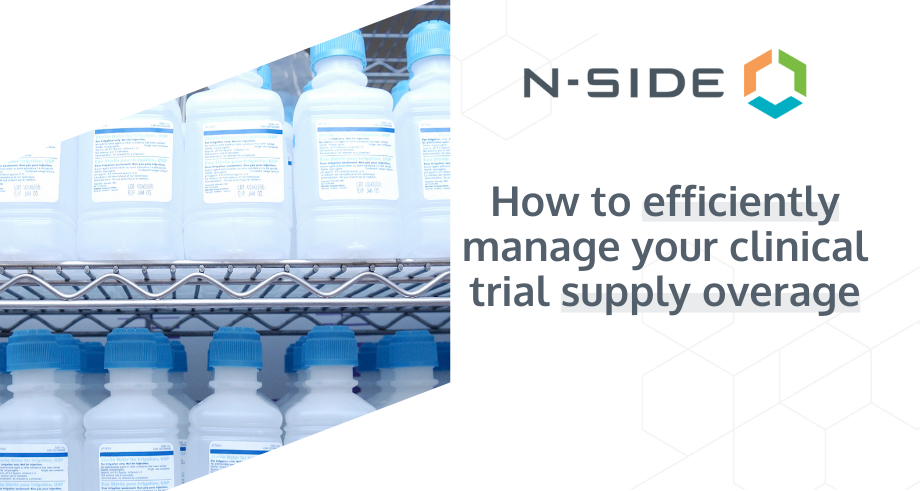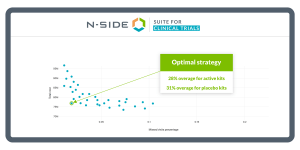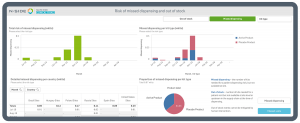Take the guesswork out of clinical trial supply overage


Clinical trial supply management is challenging – ensuring there is no risk to patients receiving the right medication on-time with highly unpredictable demand. Due to the nature of randomized clinical trials, there is inherent uncertainty in patient demand. Buffer stock, often referred to as clinical trial supply overage, is required to be sure that the right medications are on-site for possible patient dispensing. When these buffers are not consumed by patients within an expected timeframe during the trial, the result is unused, expiring drug. With the rise in biotech drugs, with increased costs and limited drug availability, there is more and more pressure to reduce the overage used in clinical trial supply management in order to decrease drug waste. The problem is that it is very difficult to assess just how much overage will be needed to avoid any risk for patients.
Without a way to measure the amount of overage needed, a certain amount of guesswork is required in planning clinical trial supplies. Often rules of thumb are used to assign a level of overage to a clinical trial, giving a certain percentage of overage per type of trial complexity factor (e.g. multiple dose levels, number of regional depots, etc). Alternatively, several different scenarios of overage levels can be calculated to see the impact on the trial planning, and taking a best guess as to which strategy may cover the risk and best fit the trial needs. These approaches can lead to either inefficient planning with increased waste and cost, or potential risk to patient dispensing. What is needed is a reliable way to assess the uncertainty in the trial and know what risks are associated with any chosen clinical trial supply strategy.
How risk-based optimization identifies the right amount of clinical trial supply overage
Risk-based optimization is a solution that accurately assesses how much overage is needed for a specific clinical trial. It quantifies the risk in any given supply strategy for the specific clinical trial protocol and evaluates the likelihood that the right medication will be on-site and on-time for dispensing to the patient, Using risk-based optimization for clinical supply planning takes the guesswork out of assessing the needed overage. The required amount of overage for any given supply strategy will be a result of the optimization.

Figure 1: Quickly identify the most efficient supply strategies and the required overage per kit type.
The results of risk-based optimization show precisely where and when risk could occur in the trial for any given supply strategy. For example, there could be a high level of risk that the local depot in Brazil could face an out of stock situation, not having enough medication to meet patient demand in two months (e.g. if recruitment is higher than expected or if patients stay longer in their treatment for an oncology trial). A strategy with this risk would not be considered as a tenable option and discarded. On the other hand, a different strategy may show a small level of risk one year from now for sites in Brazil to not have the right kit on site for patient dispensing. In this case, as there would be enough medicine in the local depot to supply the demand, and as there is time to react, this could be a viable strategy.
With risk-based optimization, the clinical supply manager has the reassurance of knowing when and where to focus his/her attention to ensure that any actions could be planned to mitigate this risk. Further, the precise amount of overage needed for the strategy is provided as an optimized output.
What to look for in a risk-based optimization solution
To properly address this need, the risk-based optimization solution must achieve at least four things. First, it must be able to capture all of the details of the clinical trial protocol and the clinical assumptions to accurately model and simulate the trial. Secondly, the solution must be efficient enough to run a high number of simulations to capture all of the different ways that the trial could unfold based on the clinical assumptions and protocol design. This is essential to reliably assess the risk. Third, the solution results must clearly indicate how to implement the best fit strategy. Last but not least, it should allow to easily monitor the accuracy of the clinical and supply forecasts, comparing these in a straight-forward way with the study actuals. This will allow the trial manager to be alerted exactly when to re-run the simulations – based on the real-time trial data – and update some supply decisions.
The N-SIDE Suite, which includes the N-SIDE Supply and Dashboard Apps, meets these criteria and provides a high level of confidence in managing risk and reducing drug waste. The N-SIDE Supply App provides the necessary level of overage as a result as well as all of the information on any potential risk in that supply strategy. The resulting overage is part of the overall strategy of IRT settings, packaging planning and depot resupply strategy. Using N-SIDE Supply App is proven to reduce drug waste by up to 40% while at the same time proactively mitigating 100% of the risk of medication not being available on-time for patients.
The Supply App is efficient and can test many different strategies in a short time, providing the results graphically and all in one place. Clinical Supply Managers stay in the driver’s seat by having the information in hand to compare different strategies. This comparison is not only based on risk and overage, but also cost and other parameters such as number of shipments and inventory levels. Knowing specifically the type of risk associated with each strategy, as well as the difference in cost and overage levels required, Clinical Supply Managers can identify the best fit approach for their trial.
The most interesting strategies can be investigated easily using the Supply App. Business intelligence dashboards, covering topics from costs to inventory levels, can be explored intuitively. Clinical Supply Managers can focus on the topics most relevant to them in their study and have the tools in hand to analyze the data. Regarding overage, for example, Clinical Supply Managers can see not only the overall overage required, but drill down to the overage level per kit type. This can be valuable information if one kit type is much more expensive or more limited in supply availability than another. Furthermore, with the N-SIDE Dashboard App, communicating information, whether as charts or data, is made simple.

Figure 2: N-SIDE Dashboard App visualizes your clinical supply strategy data to allow for intuitive supply planning and for identification of risk management action.
Focus on proactively planning for changes
Since overage is given automatically as a result from the risk-based optimization, time and energy can be put into assessing the potential evolution of the trial. What-if scenarios can easily compare the impact of different patients demands, such as slower or faster enrollment, a different drop-out rate or titration probabilities. Additionally scenarios can assess the impact of different trial design questions, from visit schedule during protocol design through to changes in the network, such as adding a local depot. With the N-SIDE Suite, the results are all in one location and can be efficiently analyzed and shared. Having the results from each scenario compared to the baseline strategy pinpoints which aspect of the clinical supply planning needs to be adjusted if that change should eventually occur.

Figure 3: Easily compare different scenarios and be ready to react to study changes.
With risk-based optimization, Clinical Supply Managers are able to focus on managing their trials in a more relaxed and efficient way, without spending time guessing what level of overage will be needed to cover the risk for patients.
To learn more about how N-SIDE Suite for Clinical Trials can help you safely decrease your overage while reducing risk for patients contact us for a demo.


